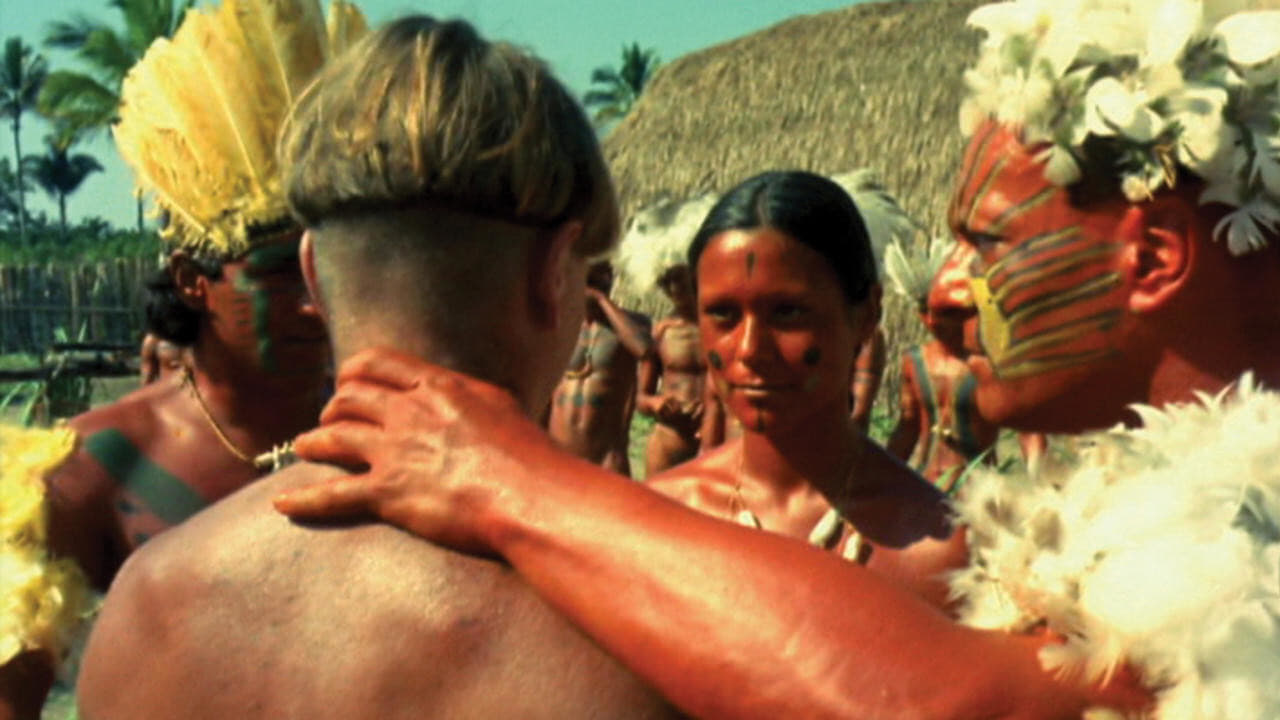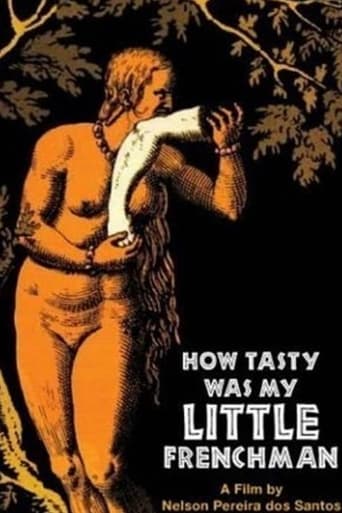

This gets plaudits for its naturalism, though it all looks pretty bogus to me and not in any way transporting. In fact it was fairly dull, the story of a westerner held captive by cannibals is almost a cliché since Melville's Typee. The twist is that the man is French but the Amazonian natives think he's Portuguese and therefore fit for the pot. They keep him for a long while as an honoured captive, native wife thrown in, pending sacrifice.Production quality is amateurish and the director would better have employed a more existential approach - someone is about to get eaten, after all. The Frenchman's attitude to his situation is comical. There's nothing stopping him escaping, but he lives there quite happily up until and including the day of the banquet in which he is plat du jour.What's really missing is atmosphere. It's all shot under bright sunlight. And given the decision to sensationalise cannibalism in the title it's easy to suppose that all the nudity is done disingenuously for lurid effect - in any case, reviewers can't help going on about it. While apt for the time and place, it is a distraction to the modern viewer and the filmmakers might somehow have cut down on the number of flapping willies (the women have tiny g-strings). Well, that's a moot point, but the overall feel is hippy-ish rather than realistic.It's a bit different but nothing special.
... View MoreI was hardly aware of the time in history depicted in this 1971 Brazilian black comedy, however that is not to say it wasn't accessible to me because the movie makes it very clear. It's set in 16th century Brazil, where rival French and Portuguese settlers are exploiting the indigineous people as confederates in their battle to assert dominance. What is particularly interesting about the movie is that it is made by the Portuguese from the point of view of the French. The hero is a likable Frenchman, the Portuguese are barbarians, and the rest of the French are oppressive and greedy. The film's Portuguese makers are objective because when all is said and done, we see that it makes no difference whose side one takes. It's about heredity overpowered by environment in a time starkly defined by tribes. Enemies are made and perpetuated, and like so, the environmental integration never progresses.A Frenchman is captured by the Portuguese is then captured by an indigenous tribe, the Tupinambas, after they massacre a group of Portuguese. The tribe's shaman predicted they would find a strong Portuguese man to cannibalize as revenge for the chief's brother being killed by a Portugeuse musket ball. Thinking the Frenchman is Portuguese, they believe they now have one. Nevertheless, the Frenchman is granted unrestrained course of the village, is sooner or later given a wife, and assumes their accustomed appearance rather than his Western clothes, or any clothes. Another Frenchman comes to the village and tells the tribe that their prisoner is indeed Portuguese, then assures the incensed Frenchman that he will tell them the truth when the Frenchman finds a secret treasure trove that another European has hidden nearby.I found the opening scene funny, because its narration apposed with its contradictions on- screen serve as great satire, even if the movie didn't seem to want to maintain that tone very much more often. It's actually not a terribly riveting film. The bountiful, essential locale, fierce way of life and ripened native women make not only the Frenchman, but us, too, forget any threat, and we have the feeling of him as a free man. It should not be that terribly hard to escape. The cannibalism is as scarce of desire as the full-frontal nudity of the cast, suggested in lieu as the representative core of Pereira dos Santos's dry political cartoon of New World mythology and undeveloped social coherence. At any rate, this 1500s-era social commentary, shot on location at a bay with 365 islands, played almost entirely nude and almost entirely written in Tupi, encourages effective breakdown of established ways which are topical because they've repeated themselves for centuries.
... View MoreThis movie is one of those that actually transports you into another time. It takes place during the 16th century with the age of colonization.It is about a Frenchman who is mistaken as an enemy of the tribe that captures him. They think he's Portugese and since all white men look the same, he is their enemy until they can be convinced otherwise. The film, shot beautifuuly, follows his adventures as he lives among the tribe as one of their own, until the appointed time he is to be eaten. The film tries to show realism, therefore everyone is totally nude as they were in that era of time. Unlike most of today's blockbusters, this film has no special effects, no explosions, and it actually has some acting. Rent it if you can, but chances are it isn't at your local quickie mart.
... View MoreI saw this movie at a college film festival back in the 70's - I have been waiting FOREVER for this movie to come out on video (finally it's out). It was made in Brazil, so I assumed that was why it hadn't made it to video yet. I have been checking video stores for the past 15 years waiting for this outstanding movie to come out! It is one of my all-time favorites - but be warned, it is weird, like Werner Herzog weird - its weirdness stems from its super-realism.The movie is based on a true incident back a few centuries ago, in pre-colonial times, when Europeans were first encountering the tribes in the Amazon. A white man is mistaken by a savage tribe of cannibals as their enemy, so they intend to kill him. Before they dispatch him, though, they make him part of their tribe (their custom). The entire movie is like watching a National Geographic documentary as he becomes an accepted member of their tribe. That's it. Cosmic plotline? No. Intense insight into the variety of human life? Definitely.Oh yeah... be warned... this film has definite nudity - this is not some Hollywood schlock flick about noble savages... this film tells it like it was (re-read above: National Geographic, super-realism)
... View More